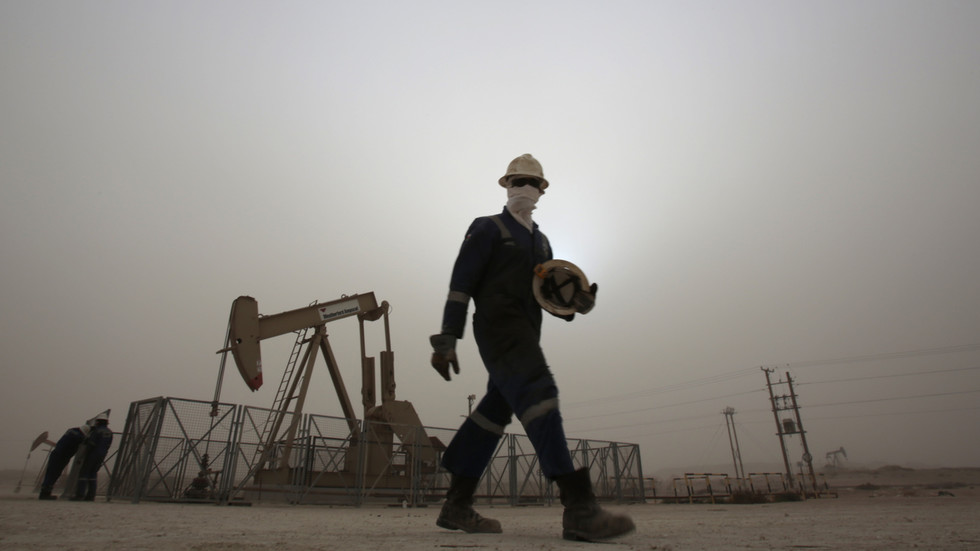
Escalating regional tensions may lead to global implications
Russian Market is a project by a financial blogger, Swiss journalist and political commentator based in Zurich. Follow him on X @runews
FILE PHOTO. An oil worker walks by an oil pump during a sandstorm that blew in, in the desert oil fields of Sakhir, Bahrain. © AP Photo/Hasan Jamali
The Israel-Hamas conflict, characterized as a ‘black swan event’ in the oil market, holds the potential to propel oil prices to $150 per barrel. This possibility is rooted in the specter of regional entanglement, particularly involving Iran. Apprehensions surround Iran’s potential support for Hamas through advanced weaponry, further escalating the conflict. Moreover, Iran’s influence on Hezbollah may open a second front against Israel, possibly prompting Israeli strikes on Iran. In response, Iran could opt to close the Strait of Hormuz, a vital global oil passage. Such an act would disrupt oil supplies, leading to price surges and contributing to inflation via increased energy costs.
The world of commodity trading stirred uneasily as the Israel-Hamas conflict unfurled unexpectedly, leaving market observers with no choice but to acknowledge its reverberations. While some may argue that this tumultuous event has had a limited impact on global oil prices and the broader economy, a closer inspection reveals a more complex reality.
In the wake of the Hamas attack on Israel, oil prices initially surged, only to retreat by day’s end. However, as the saying goes, appearances can be deceiving. This Israel-Hamas conflict, in its unpredictability, resembles a black swan event in commodity markets, a term coined by Nassim Nicholas Taleb to describe highly improbable and unforeseen events that have a profound impact on markets and society. It caught not only traders but also central banks, particularly the Federal Reserve, off-guard as they grapple with spiking US Treasury yields and inflation, euphemistically labeling it as “transitory.” In stark contrast, this Israel-Hamas conflict appears far from transitory, already spilling over its borders. If this situation escalates regionally, the disruption to energy supplies could push oil prices to the ominous $150 per barrel mark, prompting concerns about inflation and a potential economic downturn.
Read more
Through the annals of history, we’ve borne witness to geopolitical turbulence sending shockwaves through the oil markets. The Yom Kippur War of 1973, a tumultuous chapter in the history of Middle Eastern conflicts, is one such example.
As the Arab states initiated an oil embargo in response to the Yom Kippur War, the price of oil embarked on a meteoric ascent. In bustling trading hubs like New York, this surge was staggering – prices quadrupled, soaring approximately 300% to 400%, depending on the type of crude and the timeframe considered. This seismic shift rippled globally, affecting economies well beyond American shores.
On October 19, 1973, immediately following President Nixon’s request for Congress to make $2.2 billion in emergency aid available to Israel for the Yom Kippur War, the Organization of Arab Petroleum Exporting Countries (OAPEC) instituted an oil embargo on the United States. The embargo put an end to US oil imports from participating OAPEC nations, initiating a series of production cuts that significantly altered the global price of oil. These cuts nearly quadrupled the price, from $2.90 per barrel before the embargo to $11.65 per barrel in January 1974. In March 1974, amid disagreements within OAPEC on how long to continue the embargo, it was officially lifted. However, the higher oil prices persisted. (Source)
Amid this energy tempest, a crucial question emerged – how would the United States respond to this oil crisis, especially if it actively engaged in the ongoing conflict? The mere contemplation of US involvement would likely trigger a robust reaction from the Organization of Petroleum Exporting Countries (OPEC) and possibly some of its member states. This reaction might manifest as an oil embargo, targeting not only the United States but potentially extending across the Atlantic to impact Europe as well.
Read more
The Strait of Hormuz, a maritime crossroads of immense importance, holds a pivotal position in the global oil market. Approximately one-sixth of the world’s oil supply and a third of its liquefied natural gas traverse this narrow geopolitical strait. Iran controls seven of its eight islands, maintaining a military presence on each. This strategic positioning empowers Iran to potentially disrupt the smooth passage of oil, a prospect with profound implications for global energy security.
A prevailing sense arises: the shutdown or substantial disruption of the Strait of Hormuz, coupled with Russia’s oil and gas embargo, points to oil and liquefied natural gas prices reaching unprecedented heights. The situation becomes even more precarious as we witness the closing of key pipelines delivering Russian gas to Europe. This confluence of factors signals a precarious equation in which the Israel-Hamas conflict poses a significant threat to energy security in Europe, particularly as Russia’s gas supplies face impediments.
Weren’t those strategic petroleum reserves originally set up for scenarios just like wars and crises? However, despite their intended purpose, the Biden administration has been consistently depleting the Strategic Petroleum Reserve (SPR) with seemingly no intention of replenishing this essential safeguard. It begs the question: could this be a calculated strategy to undermine Russia? This inquiry lingers, reminding us that even the most seasoned traders, when swayed by emotions or animosity, can make questionable decisions. For the record, the Strategic Petroleum Reserve (SPR) was created in response to the 1973 energy crisis.
And then, the Israel-Hamas war takes center stage. What could possibly go wrong? Consider, for a moment, the impending tremor in oil prices when the Biden administration ultimately decides to refill the strategic petroleum reserves. The stage is set for a compelling drama, replete with geopolitical intricacies and economic repercussions.
As the United States depletes its strategic reserves, China aggressively builds its stockpiles through acquisitions, possibly benefiting from anticipated discounts from Russia. Simultaneously, OPEC+ and Saudi Arabia implement production cuts, creating a harmonious symphony of supply-side orchestration. This coordinated dance aligns seamlessly with the backdrop of surplus liquidity, cementing my unwavering optimism in the prospects of the crude oil market.
Read more
Nonetheless, there’s an ever-present concern that’s causing unease for both supporters of Bidenomics and the vigilant Federal Reserve Chair, Jerome Powell. The haunting prospect of resurgent inflation is potentially leading to sustained high interest rates. It’s crucial to bear in mind that history tells a somber tale: surging energy prices have often been a significant factor in tipping the US economy into a recession, especially as early indicators of demand strain start to surface.
From my perspective, when we contemplate the possibility of the US 10-year Treasury yield climbing to 6%, it’s worth mentioning that China has been notably shedding US treasuries in substantial volumes.
Moreover, the awakened behemoth that is China stands poised to significantly shape the oil landscape. China’s economic might and insatiable appetite for oil are expected to exert the most potent influence on oil prices in the year ahead. Even if OPEC+ manages to exert upward pressure on prices, the prospects of China’s demand surpassing expectations portend a seismic shift in the global oil market, as prices flirt with the elusive $150 mark.
In this oil odyssey, where geopolitics, the lack of sufficient investment, and the rise of burgeoning superpowers converge, the path to $150 is not a matter of “if,” but rather “when.” The stage is set, the players are in position, and the world eagerly anticipates the next act in this captivating drama, with the potential for a black swan event spreading its wings.




